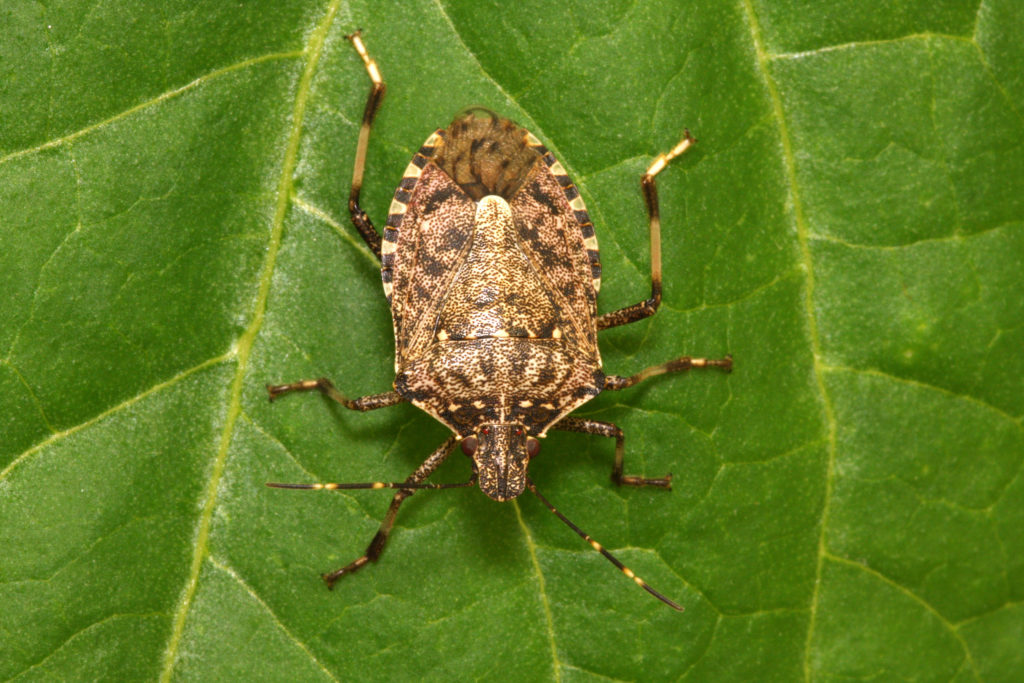Introduction
Brown marmorated stink bug (Halyomorpha halys), often abbreviated to BMSB, and sometimes referred to as a stink bug, is a true bug in the family Pentatomidae. Brown marmorated stink bug is an invasive polyphagous insect that infests various fruits, vegetables, ornamental plants, and farm crops. The insect is indigenous to Asia, where it is recognized as a significant agricultural pest.
Brown marmorated stink bug was introduced to North America from China or Japan. The first reported specimen was discovered in Allentown, Pennsylvania in September 1998. The insect likely became established in the area several years earlier. Brown marmorated stink bug has since become abundant throughout the United States. It is particularly common in the Mid-Atlantic and Northeast regions, where it frequently infests orchards and ornamental plants.
Distribution & Habitat
Brown marmorated stink bug is native to Asia, with a range encompassing China, Japan, Korea, and Taiwan. The insect’s distribution also extends across Europe, North America, and South America. In the United States, the insect has been observed in nearly every state.
Hosts
Brown marmorated stink bug infests a bevy of plants. It frequently attacks apples, blackberries, citrus fruits, field corn, sweet corn, figs, green peppers, mulberries, peaches, persimmons, and tomatoes, as well as a multitude of beans. Infestations are also common on weeds, and many ornamental plants, particularly fruit trees.
Description
Adult brown marmorated stink bugs may grow up to 17 mm long and wide. The adults are distinctly shaped; they have a narrow head, a thick abdomen, and a smooth, curved body that resembles a shield. A pair of long antennae protrude outwards from the insect’s head. The final two antennal segments feature distinct alternating light and dark brown bands. Small black, white, coppery, or metallic blue patches form on the adults’ head and pronotum. Attached to the insect’s head is a proboscis, an elongated mouthpart that the insect uses to feed. Scent glands are located on the upper surface of the abdomen, as well as on the underside of the thorax. The adults’ legs are brown with a faint speckling or banding of white.
The eggs are elliptically shaped, with a light green, light yellow, or pale red and yellow coloration. The eggs are deposited in clusters on the underside of leaves. Each cluster is composed of 20 to 30 eggs. When the nymphs first hatch, they measure around 2.4 mm in length. Once mature, the nymphs may extend up to 12 mm in length. The legs, head, and thorax of the first instar nymphs are orange or red. The nymphs’ abdomen is initially reddish-yellow, with several thick black stripes. On late instar nymphs, the color of the abdomen fades, turning white with reddish spots. Protuberances form near each of the abdominal scent glands on the dorsal surface. Several spines are located on the femure, and lateral margins of the thorax. Second instar nymphs develop a black appearance. As the nymphs continue to grow, they gradually turn brown. Early instar nymphs have deep red eyes.
Life Cycle
Depending on the geographic location and the weather conditions, brown marmorated stink bug may produce up to six generations per year. The adults emerge from their overwintering sites in spring. They navigate to susceptible plants, where they commence feeding on healthy foliage. While situated on the plants, the males emit pheremones and vibrational signals that alert the females to their presence. The females communicate in turn by emitting their own vibrational signals. Once the adults have converged upon a site, they mate. After mating, the females select a host to deposit their eggs on. The females deposit their eggs from May to August. The eggs are often laid in clusters on the underside of leaves. Each female lays between 400 and 500 eggs during her lifespan.
Four to five days later, the eggs hatch, revealing masses of small black nymphs. Over the next five weeks, the nymphs feed on nearby foliage, progressing through five instars. Ordinarily, the nymphs are solitary feeders. However, if populations are denese, the nymphs may occasionally collect between overlapping leaves, or within leaf folds. The nymphs morph into sexually mature adults following their fifth instar. From September to early October, the adults search for overwintering sites. Once they have found a suitable location, the adults overwinter and emerge the following spring.
Symptoms of Infestation
Brown marmorated stink bug causes widespread damage to fruits, vegetables, and plant foliage. The adults and nymphs use their proboscis to pierce the leaves of host plants, and consume their fluids. As they feed, the insects inject saliva into the plant. The saliva is toxic to many plants. On fruit, the persistent feeding of the insects can result in a type of distortion called cat facing, in which the fruit develops necrotic brown spots along its surface, rendering it unsuitable for consumption. This type of deformation is common on peaches. Infested apples often exhibit pitting and discoloration symptoms, as well as extensive scarring where necrotic spots have formed.
On ornamental plants, the feeding of the nymphs and adults promotes leaf stippling, which inhibits plant growth. It can also promote the degradation of plant seeds. Fruit trees will often experience a significant reduction in fruit yield. Plants that have been weakened by brown marmorated stink bug may be more easily invaded by disease pathogens, and other insects.
Allergenic Potential
Brown marmorated stink bug expresses a pungent odor from its dorsal scent glands, which can provoke an allergic reaction in some individuals. Those that are allergic to the scent of cockroaches and lady beetles are often affected. If crushed against exposed skin, brown marmorated stink bug can cause dermatitis.
Management
- Inspect windows, doors, siding, utility pipes, chimneys, and other openings for splits or fractures. If any damage is present, seal or repair the openings to reduce the number of overwintering sites available to the adults. Damaged screens on doors and windows should be maintained or replaced.
- In external areas, insecticidal applications can provide some minor control for the adults. Applications should be performed in fall before the adults overwinter. Avoid using insecticides in buildings. While insecticidal treatments are effective at moderating BMSB populations, the husks of the insects may attract carpet beetles, which will readily devour dry goods and other natural products in households.
- Brown marmorated stink bug can be removed from interior areas with the assistance of a vacuum cleaner.
- Brown marmorated stink bug has several natural predators that help to limit its populations. Parasitic wasps and birds are two of the most common predators in the insect’s native range. Trissolcus halymorphae, an egg parasitoid, has been identified as a natural control agent of BMSB. When present, Trissolcus halymorphae can encourage a rapid collapse of BMSB populations.
Photo courtesy of Melissa McMasters CC-by-2.0


